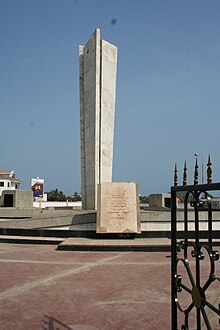Accra riots
The so-called " Accra Riots " ("Accra riots"), which broke out in Accra , the capital of the former British colony Gold Coast , in 1948 , are considered an important milestone in the struggle for the independence of the West African state of Ghana . A memorial near the current seat of government commemorates the dead of the "Accra Riots".
Soldiers of the Gold Coast Regiment fought on the British side in Abyssinia and Burma , among other places , during World War II . Out of dissatisfaction with their social situation, war veterans founded the "Gold Coast ExServicemen 'Union" in 1946. On February 28, 1948, this association organized a peaceful protest march to hand over a petition to the governor . You had been promised pensions and jobs during the war. In the petition they called for these promises to be kept.
The march to the governor's seat at Christiansborg Castle was violently stopped by the police. Three demonstrators were killed and several wounded. The fatal shots were fired by the commanding British police officer as the local police refused to open fire on the demonstrators.
This event led to unrest across the country. The British blamed the leaders of the United Gold Coast Convention (UGCC) and arrested Kwame Nkrumah , JB Danquah , Edward Akufo-Addo , William Ofori Atta , Ako Adjei and Obetsebi-Lamptey . These six leaders of the independence movement came to be known as " The Big Six ". Although their political paths later parted, their portraits are now shown together on all Ghanaian banknotes.
The events in Accra were only the trigger for the nationwide unrest. The real explanation can be found in the deteriorating social and economic situation. The post-war years in Ghana were characterized by a shortage of supplies and rising prices on the one hand and a fall in real wages on the other. In contrast to Great Britain , where similar problems were responded to through price regulation and other state intervention, the colonial administration did nothing to counter this development. In addition, the economy was dominated by large European firms, while retailing was in the hands of Lebanese and Syrian traders who had access to bank credit, which was not the case for Africans. The situation was exacerbated by a virus attack on the cocoa trees . In order to contain the disease, the colonial administration ordered the local farmers to cut down the trees, which destroyed their economic basis. In addition, there was general dissatisfaction with the slow development on the way to greater independence.
In this situation, a successful boycott movement against foreign businessmen had taken place in the first few weeks of 1948. After negotiations with the boycott movement, the colonial administration announced a reduction in prices for consumer goods for February 28th. On that day, the fatalities during the protest march of the former soldiers, which had no direct connection with the boycott movement, provided the trigger for the outbreak of unrest across the country.
The commission of inquiry set up by the British government recommended, among other things, the expansion of higher education institutions and a new constitution in order to strengthen the participation of local representatives.
literature
- Vincent N. Okyere. Ghana. A Historical Survey, Vinojab Publication, Accra 2000, pp. 153-158.
- Richard Rathbone: 'The government of the Gold Coast after the Second World War'. In: African Affairs. Vol. 67, H. 2/1968, pp. 209-218. - http://afraf.oxfordjournals.org/content/67/268/209.full.pdf
Individual evidence
- ↑ See Richard Rathbone: 'The government of the Gold Coast after the Second World War'. In: African Affairs . Vol. 67, H. 2/1968, p. 213 - Rathbone refers here to the report of the "Watson Commission", which was set up by the British government to investigate the unrest.
- ↑ See Richard Rathbone: 'The government of the Gold Coast after the Second World War'. In: African Affairs. Vol. 67, H. 2/1968, p. 210
